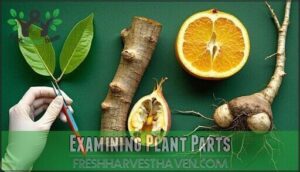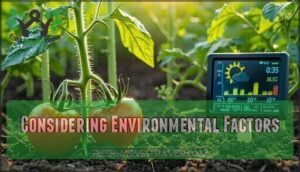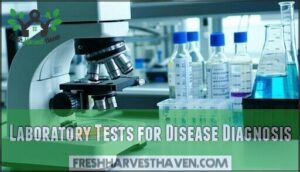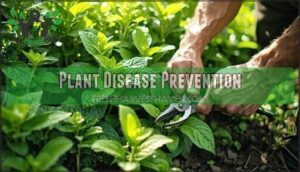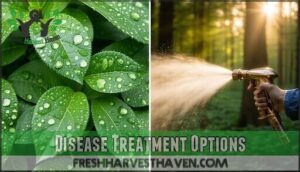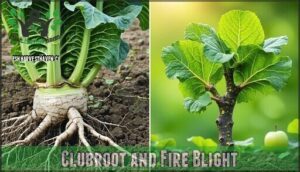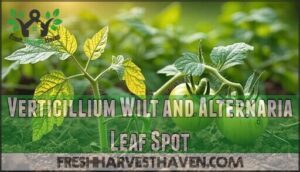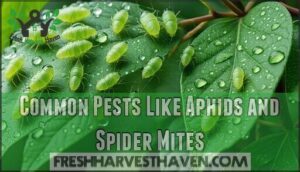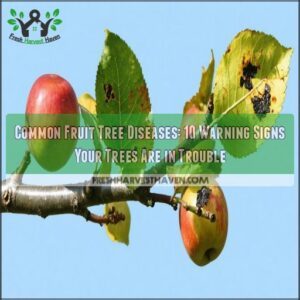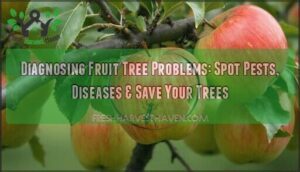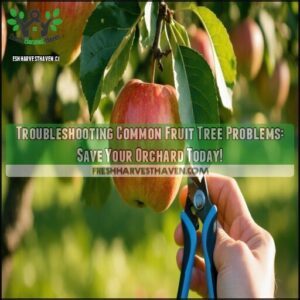This site is supported by our readers. We may earn a commission, at no cost to you, if you purchase through links.
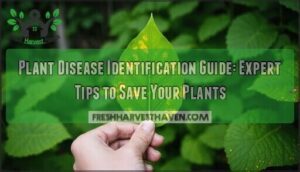 You can identify plant diseases by examining leaves, stems, and roots for telltale symptoms, looking for yellowing leaves, brown spots, wilting, white powdery coatings, or unusual growths.
You can identify plant diseases by examining leaves, stems, and roots for telltale symptoms, looking for yellowing leaves, brown spots, wilting, white powdery coatings, or unusual growths.
Different diseases create distinct patterns—fungal infections often show as spots or fuzzy growth, while bacterial diseases cause dark, water-soaked areas, and viral infections typically create mosaic patterns or stunted growth.
Check your plants weekly, focusing on environmental factors like humidity and air circulation that encourage disease development, and understand that a proper plant disease identification guide combines visual inspection with understanding growing conditions.
The key is catching problems early, before they spread throughout your garden and become harder to treat, which is why proper plant disease identification and understanding of growing conditions are crucial.
Table Of Contents
- Key Takeaways
- Plant Disease Basics
- Disease Identification Methods
- Plant Disease Prevention
- Disease Treatment Options
- Managing Specific Plant Diseases
- Frequently Asked Questions (FAQs)
- How do you identify a plant disease?
- Does your plant have a disease?
- What tools do you need to diagnose plant disease?
- Why is identifying common plant diseases important?
- What is plant disease identification & management?
- What is a positive diagnosis of a plant disease?
- How do I tell what disease my plant has?
- Is there a free app to scan plant disease?
- Can Google Lens identify plant diseases?
- How to identify fungal or bacterial infection in plants?
- Conclusion
Key Takeaways
- Inspect your plants weekly – Look for yellowing leaves, brown spots, wilting, white powdery coatings, or unusual growths on all plant parts, including stems and roots, to catch diseases before they spread throughout your garden.
- Learn disease patterns – Fungal infections show as spots or fuzzy growth, bacterial diseases create dark, water-soaked areas, and viral infections cause mosaic patterns, so you’ll know what you’re dealing with and choose the right treatment.
- Consider environmental factors – Humidity above 80%, poor air circulation, and waterlogged soil create perfect conditions for disease development, so monitoring these helps you prevent problems before they start.
- Act fast with proper tools – Remove infected plant parts with sterilized pruning shears, use organic treatments like neem oil or baking soda sprays for mild cases, and don’t hesitate to apply targeted fungicides when diseases threaten your garden’s survival.
Plant Disease Basics
Plant diseases affect millions of gardens each year, causing symptoms like yellowing leaves, dark spots, wilting, and stunted growth that can quickly spread if left untreated.
Understanding the basics of common diseases, their warning signs, and early detection methods will help you protect your plants and maintain a healthy garden.
Common Plant Diseases
Why do plants fall victim to disease? Your garden faces threats from three main culprits: fungi, bacteria, and viruses.
Understanding common plant diseases helps you recognize trouble before it spreads. Disease vectors like insects carry pathogens between plants, while host resistance varies by species.
Fungal growth thrives in humid conditions, contributing to many plant diseases. Emerging diseases can devastate crops, creating significant economic impact.
Here’s what you’ll encounter most often:
- Powdery mildew’s white, dusty coating on leaves and stems
- Root rot’s foul-smelling, blackened underground damage
- Leaf spot’s dark, water-soaked circles with yellow halos
- Blight’s rapid browning that kills entire plant sections
Disease Symptoms and Signs
Your plants speak through their symptoms—you just need to learn their language.
Your garden whispers its secrets—listen closely and you’ll hear what it needs to thrive.
Early indicators like leaf spots, discoloration, and wilting reveal underlying problems before they worsen.
Visual diagnosis becomes easier when you understand symptom progression patterns.
Environmental influence affects how diseases manifest, while host specificity determines which plants show particular symptoms.
Watch for abnormal growths, stunted leaves, and unusual patterns.
Plant disease identification starts with recognizing these plant disease symptoms through careful observation.
Importance of Early Detection
Early detection is your garden’s secret weapon—spot trouble before it spreads and your plants thrive.
Your plant disease identification guide starts with recognizing symptoms fast.
When you catch plant disease symptoms like yellowing leaves or tiny spots early, you’ll prevent loss and minimize spread throughout your garden.
Faster treatment means better plant survival rates and reduced costs from replacing dead plants.
Think of plant disease diagnosis like catching a cold—address it quickly, and you’ll recover faster.
Early detection transforms plant disease prevention from reactive scrambling into proactive garden management, giving your plants the best shot at healthy growth.
Disease Identification Methods
You’ll need systematic methods to accurately identify plant diseases and distinguish between different types of infections.
By examining specific plant parts, considering environmental conditions, and using diagnostic techniques, you can determine the exact cause of your plant’s health problems.
You can then choose the most effective treatment approach.
Examining Plant Parts
Successful plant disease identification starts with systematic inspection of each plant part.
Begin your Leaf Analysis by checking both upper and lower surfaces for spots, discoloration, or unusual patterns. Stem Inspection reveals cracks, cankers, or abnormal swelling that signal disease.
Root Examination uncovers rot, discoloration, or stunted growth below ground. Don’t skip Flower Assessment and Fruit Observation—wilted blooms or damaged fruit often provide key diagnostic clues.
Accurate identification relies on garden pest basics to understand the causes. This methodical approach to examining plant parts guarantees accurate plant disease diagnosis and faster treatment decisions.
Considering Environmental Factors
Environmental factors act like detectives’ clues when diagnosing plant diseases. Your garden’s conditions directly influence which pathogens thrive and spread.
Your garden’s environment tells the disease story—humidity, temperature, and soil conditions reveal which pathogens are winning the battle.
Soil Health, Air Quality, and Water Sources create the perfect storm for disease development. Climate Impact and Microclimates around your plants determine infection rates.
Monitor these key environmental factors for accurate plant disease identification:
- Humidity levels above 80% encourage fungal spores
- Temperature control fluctuations stress plant immunity
- Poor drainage creates waterlogged conditions favoring root rot
Laboratory Tests for Disease Diagnosis
When visual symptoms leave you stumped, laboratory tests provide definitive answers.
PCR testing detects specific pathogen DNA with remarkable precision. Microscopy analysis reveals fungal structures invisible to naked eyes.
ELISA methods identify bacterial and viral proteins quickly. Culture techniques grow pathogens for detailed study.
Consider a digital disease submission for a quicker diagnosis.
Visit a plant diagnostic clinic for accurate disease diagnosis when home identification fails completely.
Plant Disease Prevention
You can protect your plants from disease by creating healthy growing conditions and maintaining proper garden hygiene.
Prevention works better than treatment, so focus on good watering practices, adequate spacing, and regular removal of dead plant material to ensure a healthy garden environment with proper garden hygiene.
Proper Watering and Sunlight
Getting your watering techniques and sunlight needs right prevents most plant diseases.
Think of water and light as your plant’s daily vitamins—too much or too little causes problems.
- Check soil moisture before watering to avoid overwatering risks
- Match light spectrum requirements to your plant’s specific sunlight needs
- Watch for underwatering signs like wilting or dry, cracked soil
Proper plant care through balanced watering and adequate sunlight strengthens your plant’s natural defenses, making plant disease identification less necessary.
Maintaining Good Air Circulation
After proper watering and sunlight, you’ll want to give your plants room to breathe. Spacing plants correctly prevents humid pockets where diseases thrive.
Pruning techniques like thinning dense foliage open pathways for good airflow. Greenhouse ventilation becomes critical in enclosed spaces—crack windows or use fans. Wind protection matters too; gentle breezes help, but harsh winds stress plants.
These airflow benefits make plant disease prevention easier. Think of plant spacing and pruning as giving your garden fresh air therapy.
Removing Dead or Infected Plant Parts
Good airflow sets the stage, but you’ll need to take action when disease strikes.
Pruning techniques start with identifying problem areas—look for wilted, spotted, or discolored foliage. Use sterilized pruning shears to make clean cuts just above healthy tissue.
Infected leaf removal stops disease from spreading to neighboring plants. Safe disposal means bagging debris rather than composting it, since many pathogens survive the composting process.
Wound treatment with proper cuts helps plants heal faster. These plant disposal methods and preventing spread tactics keep your garden healthy year-round.
Using Sterilized Tools
After removing diseased plant material, you’ll need clean tools to prevent spreading infections. Tool sanitation stops pathogens from hitching rides between your plants. Think of your pruning shears as surgical instruments—they need the same care.
Here are proven sterilization methods:
- Wipe blades with 70% alcohol between cuts
- Use 10% bleach solution for stubborn pathogens
- Store clean tools in dry locations to prevent rust
- Sharpen blades regularly—clean cuts heal faster
- Apply disinfectant before switching plant varieties
This simple step prevents cross-contamination throughout your garden. Regular sterilization is key to preventing common garden diseases.
Disease Treatment Options
Once you’ve identified a plant disease, you’ll need to choose the right treatment method to stop its spread and restore your plant’s health.
Your options range from gentle organic solutions like neem oil and baking soda sprays to stronger chemical fungicides, plus biological controls that use beneficial organisms to fight harmful pathogens.
Organic Treatment Methods
After preventing diseases, you’ll sometimes need organic treatment methods to tackle existing problems.
Natural fungicides like Neem Oil and Baking Soda sprays effectively combat fungal infections without harsh chemicals. Copper Sprays work against bacterial diseases, while Companion Planting with marigolds deters pests naturally.
Introducing quality compost enhances soil fertility and naturally suppresses pathogens.
| Organic Treatment | Target Disease/Pest |
|---|---|
| Neem Oil Spray | Powdery mildew, aphids |
| Baking Soda Solution | Black spot, leaf blight |
| Copper Fungicide | Fire blight, bacterial canker |
| Compost Tea | Root rot, soil pathogens |
| Beneficial Microbes | Various fungal diseases |
These natural alternatives support plant disease identification efforts while promoting healthier gardens through plant remedies and organic treatment methods.
Chemical Treatment Methods
Organic methods don’t always cut it when plant diseases rage out of control. Chemical treatment methods become your heavy artillery against severe infestations that threaten your garden’s survival.
Systemic fungicides move through plant tissues, providing long-lasting protection from within. Contact fungicides create protective barriers on leaf surfaces. Both require careful chemical application timing and proper mixing ratios.
These applications often involve specific product types for effective treatment.
Consider chemical intervention when:
- Disease spreads rapidly despite organic efforts
- Weather conditions favor aggressive fungal growth
- Valuable plants face immediate threat
- Resistance management requires rotating active ingredients
- Prevention beats cure for susceptible varieties
Always weigh environmental impact against benefits before applying any chemical treatments.
Biological Controls for Disease Management
While chemical treatments work fast, biological controls offer sustainable plant disease management.
Beneficial microbes like Bacillus and Trichoderma fungi colonize roots, creating protective barriers through disease suppression.
Natural predators target harmful insects, while antagonistic organisms compete for nutrients.
These integrated strategies promote resistance induction, strengthening your plants’ natural defenses.
Biological controls work slower than chemicals but build lasting disease resistance without environmental harm.
Fungicide Alternatives and Natural Remedies
Beyond biological controls, natural fungicides offer powerful plant disease remedies without harsh chemicals.
Milk solutions (50:50 with water) effectively combat powdery mildew. Sulfur dusting prevents fungal diseases, though proper protection matters.
The Cornell Formula combines baking soda, horticultural oil, and dish soap for thorough coverage. Neem oil serves dual purposes as fungicide and immunity booster.
Copper sprays work well but require careful application. Many gardeners now buy effective solutions for their gardens.
These fungicide alternatives provide eco-friendly options that won’t harm beneficial insects or soil health.
Managing Specific Plant Diseases
Once you’ve identified the specific disease affecting your plants, you’ll need targeted treatment strategies that work for each condition.
Different diseases require different approaches, from adjusting watering schedules for root rot to applying specific fungicides for powdery mildew, so understanding the unique needs of each problem helps you choose the most effective solution, which involves effective solution approaches tailored to the specific disease.
Powdery Mildew and Black Spot
White powdery patches signal powdery mildew, while black spot creates dark leaf lesions.
These fungal plant diseases require immediate plant disease identification for effective treatment. One approach involves using milk sprays as an organic treatment.
Mildew Prevention and Black Spot Cure strategies:
- Remove infected leaves before Rose Blackspot spreads
- Improve air circulation around vulnerable plants
- Apply fungicides early for Powdery Mildew ID
- Water soil directly, avoiding wet foliage
- Consider Fungicide Resistance when selecting treatments
Clubroot and Fire Blight
Garden destroyers like clubroot and fire blight demand swift action for effective plant disease identification guide success.
You’ll recognize clubroot through swollen, deformed roots and stunted brassica growth, while fire blight causes rapid branch browning in apple trees.
Combat clubroot’s lifecycle by adjusting soil pH and selecting resistant varieties.
Prevent fire blight spread through proper pruning techniques during dry weather, always disinfecting tools between cuts for superior plant disease diagnosis techniques.
Verticillium Wilt and Alternaria Leaf Spot
Verticillium Wilt strikes over 300 plant species, causing one-sided yellowing and dark vascular streaks. Alternaria Leaf Spot creates distinctive target-shaped lesions with dark centers.
For effective plant disease identification, compare these symptoms carefully.
Break the disease cycle through crop rotation and soil solarization. Choose resistant varieties whenever possible.
These fungal diseases require different management approaches, so accurate plant disease symptoms identification prevents treatment mistakes and protects your garden’s health.
Common Pests Like Aphids and Spider Mites
Across your garden, tiny aphids cluster on new growth while spider mites create fine webs beneath leaves.
These insect pests multiply rapidly—aphids reproduce every week, spider mites even faster in hot weather.
Spider mite damage appears as stippled, yellowing leaves.
For effective aphid control, spray insecticidal soaps or release ladybugs and other natural predators.
Understanding each pest lifecycle improves your plant disease identification skills and timing of treatments.
Frequently Asked Questions (FAQs)
How do you identify a plant disease?
You’ll spot plant diseases by examining leaves for spots, discoloration, or unusual markings.
Check stems, roots, and flowers too.
Look for wilting, stunted growth, powdery substances, or rotting areas that signal trouble.
Does your plant have a disease?
Check your plant’s leaves for unusual spots, yellowing, or wilting. Look for white powdery coating, dark patches, or stunted growth. These symptoms often signal disease, especially when proper watering continues.
What tools do you need to diagnose plant disease?
You’ll need a magnifying glass for close inspection, clean pruning shears, a notebook for recording symptoms, and your smartphone’s camera to document affected areas for later reference or expert consultation.
Why is identifying common plant diseases important?
Identifying common plant diseases quickly saves your garden from widespread damage.
Early detection prevents costly plant loss, protects neighboring plants, and helps you choose the right treatment before problems spiral out of control, which is crucial for early detection.
What is plant disease identification & management?
Think plants are invincible? They’re not.
Plant disease identification involves recognizing symptoms like leaf spots, wilting, and discoloration.
Management includes prevention through proper spacing, sanitation, and treatment using fungicides or natural remedies.
What is a positive diagnosis of a plant disease?
A positive diagnosis confirms you’ve correctly identified the specific pathogen causing your plant’s symptoms.
You’ll match visible signs like leaf spots, wilting, or discoloration with known disease patterns through careful observation and testing.
How do I tell what disease my plant has?
Look for telltale signs like leaf spots, wilting, discoloration, or unusual growths.
Check all plant parts including roots, stems, and leaves.
Compare your observations with disease guides to narrow down the culprit.
Is there a free app to scan plant disease?
Yes, several free apps can help you identify plant diseases.
These apps, such as PlantNet, PictureThis, and PlantIn, offer disease scanning features.
However, these apps aren’t perfect—they’re best used alongside visual inspection and expert advice.
Can Google Lens identify plant diseases?
Google Lens can identify plants but isn’t specifically designed for disease diagnosis.
While it might recognize some obvious symptoms, you’ll get better results using dedicated plant disease apps like PlantNet or iNaturalist for accurate identification.
How to identify fungal or bacterial infection in plants?
Check your plant’s leaves for dark, water-soaked spots with yellow halos—that’s bacterial infection.
Fungal problems show up as powdery white coating, orange rust pustules, or fuzzy growth on stems and leaves.
Conclusion
Remember when your grandmother could spot a sick tomato plant from across the garden?
She’d developed that keen eye through years of experience.
You’re now building that same expertise with this plant disease identification guide.
Early detection remains your strongest weapon against plant diseases.
Check your plants weekly, understand environmental triggers, and don’t hesitate to act when you spot trouble.
With practice, you’ll develop the instincts needed to keep your garden healthy and thriving year-round.
- https://link.springer.com/chapter/10.1007/978-981-96-4241-0_19
- https://plantarc.com/wp-content/uploads/2022/06/Plant-Pathology-Advances-in-Disease-Diagnosis-and-Management-1.pdf
- https://www.iipseries.org/assets/docupload/rsl2024041EC5454148EC2.pdf
- https://pmc.ncbi.nlm.nih.gov/articles/PMC8003093/
- https://www.flickr.com/photos/scotnelson/?

